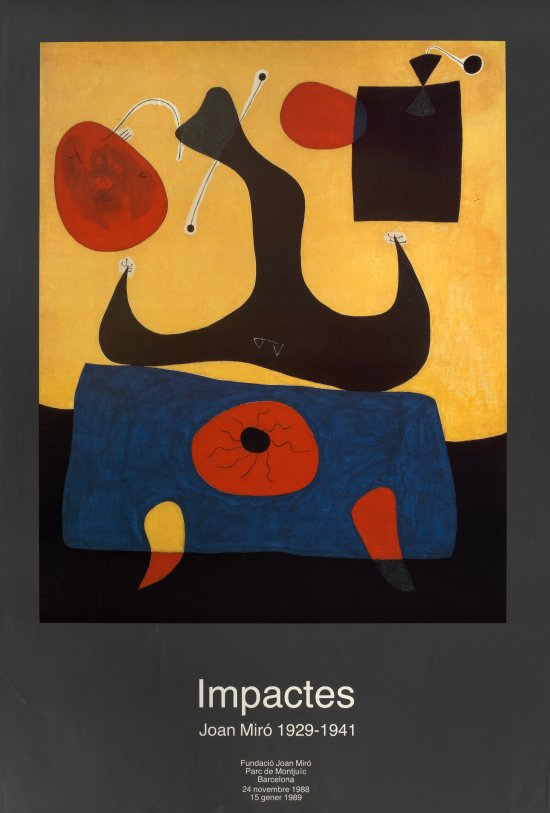- Dates
- —
- Curated by
- Rosa Maria Malet
Press Release
Impactes. Joan Miró: 1929-1941 (Impacts. Joan Miró: 1929-1941)
24 November–15 January 1989
Fundació Joan Miró
Parc de Montjuïc
08004 Barcelona
Tel.: (+34) 933 291 908
Fax: (+34) 933 298 609
From 24 November 1988 to 15 January 1989, the Fundació Joan Miró presents the exhibition Impactes. Joan Miró: 1929-1941.
The exhibition, curated by Rosa Maria Malet, features 80 paintings from private collections and museums in various countries, including the Guggenheim Museum and the Museum of Modern Art in New York, the Tate Gallery in London, among others. It also includes sketchbooks and more than 40 drawings from the Fundació Joan Miró’s collection, as well as a selection of graphic works (the complete Barcelona Series), also from the Foundation’s holdings. After its closure in Barcelona, the exhibition will travel to London, where it will be shown at the Whitechapel Gallery, one of the UK’s most prestigious institutions dedicated to contemporary art.
This exhibition offers the public in Barcelona an opportunity to discover one of the defining moments of the work of one of the most important artists of our time. The displayed works will include Joan Miró’s pivotal contributions to 20th-century art, many of which have never before been exhibited in Barcelona.
The 1930s were a decisive period in Joan Miró’s career. While the 1920s marked his transition from figurative work to a world of personal symbols and signs, poetry and dreams, the 1930s – and, in fact, the late 1920s – saw Miró experience a crisis of expression that led him to question the validity of his work. He wanted to “murder painting” and sought refuge in new techniques and materials.
Collage and drawing, as well as the incorporation of materials and objects onto the canvas, gradually led him to explore the use of volume. Although these new approaches opened up alternative paths, Miró never abandoned painting.
By the mid-1930s, alongside technical changes (the use of different colours, new supports such as copper, particle board and sandpaper), formal changes also emerged. Poetry seemed to have made its way into reality – a generic reality (the woman, the birds) that turned aggressive, as seen in the “wild paintings”, due to his rejection of the Spanish Civil War. One example is Still Life with Old Shoe, which is now part of the Museum of Modern Art in New York and represents a partial return to figuration, and La dona en revolta (Woman in Revolt), which is in the Centre Georges Pompidou in Paris. This mood, which was not improved by the outbreak of World War II, triggered a new crisis and led Miró to a process of introspection, already hinted at in the series El vol d’un ocell damunt la plana (The Flight of a Bird Over the Plain). This process culminated in the Constel·lacions (Constellations), four of which are featured in the exhibition. These works represent the formal and conceptual consolidation of his pictorial language. In terms of form, Miró developed his distinctive method of using colours in checkerboard patterns, creating multiple tones when two planes overlapped. His personal symbol vocabulary also took shape, which he would go on to use to depict his usual themes: stars, women and birds.
To complement the Impactes exhibition, the Fundació Joan Miró, in collaboration with the Institut d’Humanitats, the Institute of North American Studies and the Institut Britànic, will host two conferences under the title On pot portar la mort de la pintura? (Where Can the Death of Painting Lead?). These will take place on 13 and 15 December at the Fundació Joan Miró Auditorium.
The lectures will be given by Dr. Christopher Green from the Courtauld Institute of Art in London and Professor Hilton Cramer from New York. Barcelona, November 1988.


